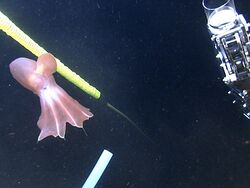Biology:Cirroteuthis
| Cirroteuthis | |
|---|---|

| |
| Cirroteuthis muelleri observed during the Arctic 2005 Exploration, NOAA-OE | |
| Scientific classification | |
| Domain: | Eukaryota |
| Kingdom: | Animalia |
| Phylum: | Mollusca |
| Class: | Cephalopoda |
| Order: | Octopoda |
| Family: | Cirroteuthidae |
| Genus: | Cirroteuthis Eschricht, 1836 |
| Species: | C. muelleri
|
| Binomial name | |
| Cirroteuthis muelleri Eschricht, 1836[1]
| |
| Synonyms | |
| |
Cirroteuthis muelleri, also known as the big-finned jellyhead,[2] was the first cirrate octopus species (and genus) to be scientifically described (in 1836). It is closely related to the genus Cirrothauma within the family Cirroteuthidae.[3] At present the genus contains a single recognized species restricted to the Arctic Ocean and northern basins of the Atlantic and Pacific, but other species may be present in the southern hemisphere.[4][5]
Description
Cirroteuthis muelleri can reach a maximum length of 400 mm (mantle length 170 mm).[6] Statements that C. muelleri reaches up to 1.5 m total length are erroneous (and involve unidentified Cirrothauma, then regarded as Cirroteuthis sp.[7], being mistakenly assumed to be C. muelleri).[5][6] It is off white or pale purple, with the inner side of the arms and the webs being brownish-purple.[4]
The head has well developed eyes with lenses. The upper and lower beaks are thin and relatively weak. The body is gelatinous and fragile. The arms are nearly equal in length. A pair of translucent webs joins the dorsal and ventral sides of the arms together and the webs terminate at a nodule. The first 7 or 8 suckers are cup-shaped and raised on thick stalks, numbers 2 and 3 being the largest. There are a further 30 or so smaller suckers with delicate stalks. Between the suckers are conspicuous cirri up to 19 mm (0.75 in) long. These are elongate, fleshy tendrils set along the sides of the oral surface of the arms, the longest being in the mid-arm region. Both the suckers and the cirri do not extend as far as the tip of the arm.[4][8]
The fins are elliptical when viewed from the side. They are wide, and longer than the width of the head. The aperture of the mantle is narrow and the funnel is long.[8]

Distribution
Cirroteuthis muelleri is a deep sea species. It is found in cold seas in the boreal Arctic, the north Atlantic Ocean, and the north Pacific Ocean.[1] In the southern hemisphere at least three specimens have been captured of Cirroteuthis cf. muelleri from New Zealand and Australia, which may represent a new species.[5][9]
Habitat
Cirroteuthis muelleri is benthopelagic, meaning it is found swimming or drifting in the 10 m (33 ft) or so immediately above the sea bed. It is usually found at depths of over 2,000 m (6,600 ft).[8] At these depths, practically no light penetrates, the temperature is about 4 °C, and observation is only possible by submersible, which makes these octopuses difficult to collect. Their ecology and biology are little known, but they seem to be fairly common in the seas around Greenland.
Biology
In a study of Arctic cephalopods, three specimens of Cirroteuthis muelleri, all female, were caught near the ocean floor at 3,000–3,300 m (9,800–10,800 ft). The eggs were found to be large and were laid on the bottom, singly.[10] The diet of C. muelleri (from stomach contents of 18 specimens) was found to comprise small crustaceans (Calanoida, Mysidacea, Isopoda) and polychaetes (Polynoidae), all small benthic or epibenthic prey items. The largest mysids consumed were estimated at 14.6 mm long, and the largest polychaete was estimated at 24.3 mm.[6]
References
- ↑ 1.0 1.1 Cirroteuthis muelleri - Eschricht, 1836. World Register of Marine Species. Retrieved 2011-10-03.
- ↑ O'Shea, Steve (March 9, 2019). "Deep-sea finned Octopoda of New Zealand". https://tonmo.com/articles/deep-sea-finned-octopoda-of-new-zealand.25/.
- ↑ Piertney, Stuart B.; Hudelot, Cendrine; Hochberg, F. G.; Collins, Martin A. (2003-05-01). "Phylogenetic relationships among cirrate octopods (Mollusca: Cephalopoda) resolved using mitochondrial 16S ribosomal DNA sequences" (in en). Molecular Phylogenetics and Evolution 27 (2): 348–353. doi:10.1016/S1055-7903(02)00420-7. ISSN 1055-7903. PMID 12695097. https://www.sciencedirect.com/science/article/pii/S1055790302004207.
- ↑ 4.0 4.1 4.2 Vecchione, M. & R.E. Young 2003. Cirroteuthis Eschricht, 1836. The Tree of Life Web Project.
- ↑ 5.0 5.1 5.2 Verhoeff, Tristan Joseph (2022-06-17). "Finned octopus Cirroteuthis Eschricht, 1836 (Cephalopoda: Cirrata: Cirroteuthidae) confirmed from Australian waters". Molluscan Research 42 (3): 205–211. doi:10.1080/13235818.2022.2087143. ISSN 1323-5818. https://doi.org/10.1080/13235818.2022.2087143.
- ↑ 6.0 6.1 6.2 Golikov, Alexey V.; Artemev, Gleb M.; Blicher, Martin E.; Gudmundsson, Gudmundur; Jørgensen, Lis L.; Olafsdottir, Steinunn H.; Walkusz, Wojciech; Zakharov, Denis V. et al. (2022-03-01). "Deep and cold: are Boreal and Arctic finned octopods, Stauroteuthis syrtensis and Cirroteuthis muelleri (Cephalopoda, Octopoda, Cirrata), ecological analogues?" (in en). Deep Sea Research Part I: Oceanographic Research Papers 181: 103706. doi:10.1016/j.dsr.2022.103706. ISSN 0967-0637. Bibcode: 2022DSRI..18103706G. https://www.sciencedirect.com/science/article/pii/S096706372200019X.
- ↑ Roper, Clyde F. E.; Brundage, Walter L. (1972). "Cirrate octopods with associated deep-sea organisms: new biological data based on deep benthic photographs (Cephalopoda)". Smithsonian Contributions to Zoology 121 (121): 1–46. doi:10.5479/si.00810282.121. https://doi.org/10.5479/si.00810282.121.
- ↑ 8.0 8.1 8.2 Cirroteuthis muelleri. Marine Species Identification Portal. Retrieved 2011-10-03.
- ↑ O'Shea, Steve (1999). "The marine fauna of New Zealand: Octopoda (Mollusca: Cephalopoda)". NIWA Biodiversity Memoirs 112: 5–278.
- ↑ Nesis, Kir N. (2001). "West-Arctic and East-Arctic distributional ranges of cephalopods". Sarsia 86: 1–11. doi:10.1080/00364827.2001.10420456. Archived from the original on 2012-04-15. https://web.archive.org/web/20120415030314/http://www.bio.uib.no/sol/PDF/86%281%291.pdf. Retrieved 2011-10-03.
Wikidata ☰ Q18195570 entry
 |

